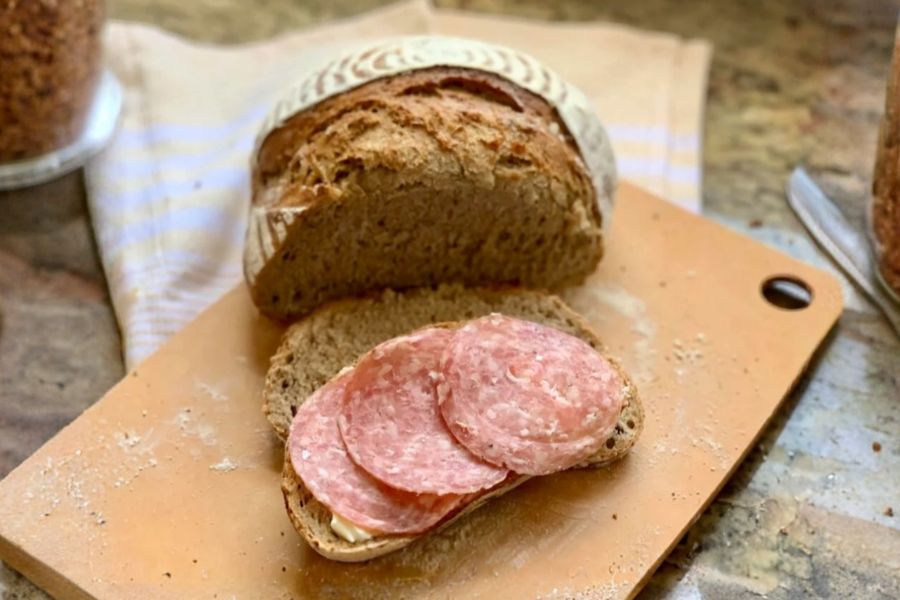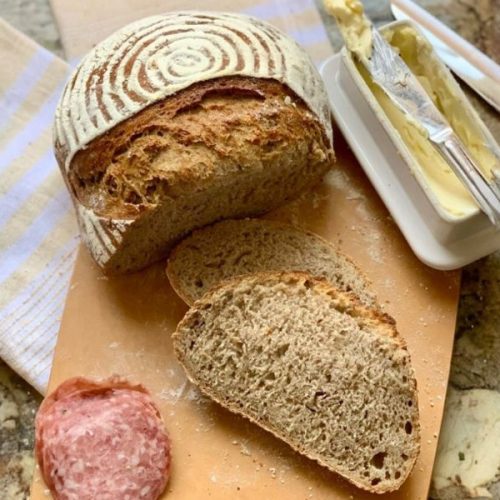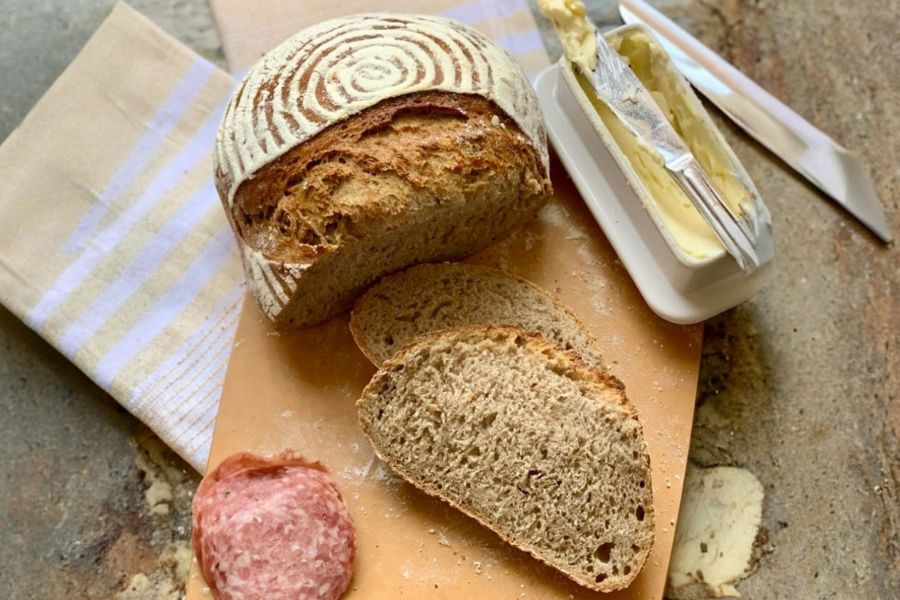This Sourdough Rye Bread is a hearty, aromatic loaf that brings the flavors of traditional Central European baking to your kitchen.
Its deep, earthy notes come from a combination of rye and whole wheat flours, complemented by the subtle, nutty zing of caraway seeds.
Made entirely with sourdough, this bread offers natural fermentation benefits, making it easier to digest and promoting gut health.
Rye and whole wheat provide a fiber-rich base, supporting satiety and steady energy, while the natural sourdough starter contributes plant-based protein and enhances flavor complexity.
Low in saturated fat and packed with nutrients, this bread is a wholesome alternative to store-bought loaves. It’s versatile enough for everyday use—perfect for sandwiches, toast, or alongside soups and stews.

With thoughtful hands-on steps like stretching, folding, and scoring, this recipe not only produces a visually stunning loaf but also allows bakers to connect with the art of bread-making.
Must-Have Tools for Perfect Results
Dutch Oven
Ideal for baking artisan loaves with a crisp, golden crust. Its heavy lid traps steam, creating bakery-style results at home. Perfect for all types of bread.
Mixing Bowl Set
Essential for combining levain and dough efficiently. Durable bowls make kneading, folding, and mixing clean and simple while accommodating rising dough.
Kitchen Scale
Ensures precise measurement of flour, water, and levain for consistent results. Precision scales are invaluable in baking where accuracy affects texture and rise.
Bread Banneton
Provides structure during the final rise and helps achieve a taut, aesthetically pleasing loaf with excellent shape and pattern. Can also be used for all yeast-based breads.
Bread Lame
A sharp scoring tool for making clean, controlled cuts in dough before baking, allowing for proper oven spring and professional-looking artisanal loaves.

Authentic Sourdough Rye Bread
Equipment
- 1 Mixing Bowl
- 1 Dutch oven
- 1 Kitchen Scale
- 1 Bread Banneton
- 1 Bread Lame
Ingredients
Levain (Overnight 10–12 hours):
- 10 g sourdough starter ~2 tsp
- 50 g rye flour ~1/3 cup
- 50 g all-purpose flour ~1/3 cup
- 100 g water ~2/3 cup
Sourdough Rye Dough:
- 200 g levain all prepared levain, ~2/3 cup heaping
- 650 g water ~2 3/4 cups at room temperature
- 200 g rye flour ~1 1/2 cups
- 200 g hard whole wheat flour ~1 1/2 cups
- 600 g bread flour ~4 1/4 cups
- 20 g salt ~1 tbsp
- 10 g caraway seeds ~1 tbsp
Instructions
- Prepare the Levain: In a small mixing bowl, combine 10 g sourdough starter, 50 g rye flour, 50 g all-purpose flour, and 100 g water. Stir until smooth, cover the bowl, and leave at a warm 78–80°F (25–27°C) for 10–12 hours or overnight. The levain is ready when it becomes bubbly, peaks slightly, and has a pleasant fermented aroma.
- Mix the Dough: In a large bowl, combine 200 g prepared levain, 650 g room-temperature water, 200 g rye flour, 200 g whole wheat flour, 600 g bread flour, 20 g salt, and 10 g caraway seeds. Use your hands or a dough whisk to mix thoroughly until all ingredients are hydrated and form a sticky, cohesive dough.
- Stretch and Fold: Cover the dough and perform a series of four stretch-and-folds every 30 minutes over 2 hours. To fold, lift the underside of the dough and fold it over itself, rotating the bowl after each fold. This develops gluten, strengthens the dough, and improves structure.
- Bulk Fermentation: After the final fold, cover the dough and let it rest on the counter for 2–3 hours until puffed and slightly domed. Check that the dough temperature remains around 78–80°F. Warm kitchens may need only 2 hours; cooler environments may take up to 4 hours.
- Shape the Loaves: Gently divide the dough in half. Pull the edges toward the center to create a taut, round loaf, then flip it over and use a circular dragging motion on the countertop to further tighten the surface. Place each loaf in a floured banneton or bowl, seam-side down, and cover to rise for 2–4 hours or refrigerate overnight for a slow, cold proof.
- Preheat Oven: Place a baking stone or Dutch oven in the oven and preheat to 500°F (260°C) at least 20 minutes before baking. If using a Dutch oven, preheat it with the lid on. Prepare a pan with ice cubes for steam if baking on a stone.
- Score and Bake: Carefully turn the risen loaves onto parchment, score the tops with a bread lame or sharp knife, and transfer to the oven. Bake at 450°F (232°C) for 45 minutes.If using a Dutch oven, cover for the first 25 minutes, then uncover and bake for another 20 minutes until golden and crusty. Cool completely before slicing to ensure the interior sets.
Notes
- Use a kitchen scale for precise measurements; sourdough baking is highly sensitive to flour-to-water ratios.
- Whole wheat flour can be substituted with white whole wheat if you prefer a milder flavor.
- Caraway seeds add traditional flavor, but you can reduce or omit them for a subtler taste.
- Refrigerating the shaped dough overnight allows for slow fermentation and deeper flavor development.
- Let the bread cool completely before slicing to avoid a gummy interior.
Chef’s Secrets for Perfect Rye
Achieving a beautifully textured sourdough rye bread starts with properly fermented levain.
Make sure it is bubbly and active before mixing the dough.
Stretch-and-fold techniques during bulk fermentation are critical for developing gluten structure and elasticity, especially since rye flour has less gluten.
Using a Dutch oven or a baking stone with added steam helps create a crisp, artisan-style crust.
If you refrigerate the dough overnight, bake it straight from the fridge for enhanced flavor and a slightly denser crumb.
Finally, scoring the loaves just before baking allows controlled expansion and an appealing rustic look.
Serving Suggestions for Bread Lovers
This sourdough rye bread pairs beautifully with butter, cheeses, and cured meats for a simple sandwich.
It’s excellent with smoked salmon, cream cheese, or hearty soups and stews.
Toast slices lightly and drizzle with honey or fig jam for a sweet contrast to the earthy rye.
For brunch, serve it alongside avocado, eggs, and fresh greens. Its robust flavor makes it versatile for both savory and sweet accompaniments
Storage Tips for Freshness
Store at room temperature in a paper bag for up to 3 days to maintain crust crispness.
For longer storage, wrap in plastic and refrigerate for up to a week, though crust may soften. For extended storage, slice the bread and freeze in airtight freezer bags for up to 3 months.
Reheat frozen slices in a toaster or oven for the best texture.
Avoid storing in a sealed container at room temperature for long periods, as moisture can lead to mold.
Frequently Asked Questions About Rye
1. Can I use all-purpose flour only?
Yes, but the flavor will be milder, and the texture slightly less dense. You may also need to adjust hydration for the best dough consistency.
2. Do I need a sourdough starter?
Yes, this bread relies on a natural starter for flavor and rise. You can create one at home if you don’t already have an active starter.
3. Can I omit caraway seeds?
Absolutely. Caraway seeds give a traditional rye flavor but can be omitted for a subtler bread. You can also experiment with fennel or anise seeds.
4. How do I know when the bread is done?
The crust should be deep golden brown, and an internal temperature of 200–205°F (93–96°C) indicates fully baked bread. Tap the bottom—hollow sound confirms doneness.
5. Can I refrigerate dough overnight?
Yes, refrigerating the shaped dough enhances flavor and slows fermentation. Bake straight from the fridge; scoring cold dough ensures proper expansion.
This recipe has been adapted and simplified from the original version by amybakesbread. We’ve refined the steps for a smoother cooking experience and added helpful notes, nutrition insights, and essential kitchen tools to make it even easier for home cooks.

